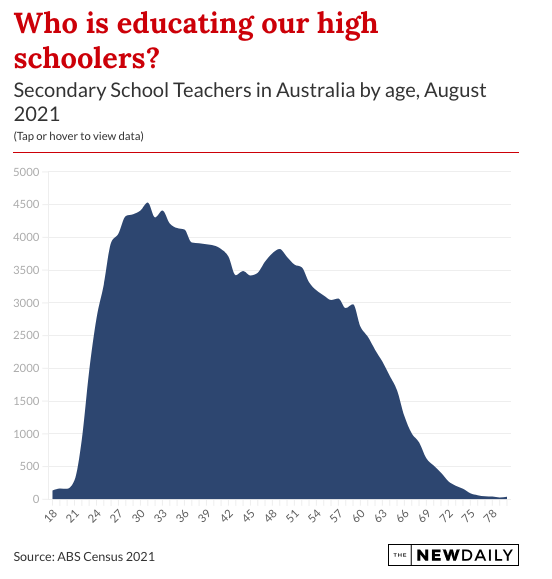Without enough teachers Australia won’t make the grade
Our resident demographer checks the stats for answers to the perennial teacher shortage problem.


I wrote previously about why the current skills shortage will persist in the coming decade despite our record migration intake. Today we will look at one occupation where a shortage of workers will have terrible consequences: we are simply running out of teachers.
We are only going to look at secondary school teachers and ignore primary school teachers for this short column. Trends are roughly the same though. Let’s get started.
As of the 2021 Census, we have 156,000 secondary school teachers in Australia.
The population of secondary-school age (10-18) students will grow by only four per cent in the next decade (from 2.93 million to 3.05 million). If Australia grows by a whopping 14 per cent during that period, why should we be worried about a lack of teachers?
Well, assuming the current teacher-to-student ratio, we will need to add four per cent more teachers to the workforce. Four per cent of 156,000? That’s around 6000. Surely we can train and educate just over 6,000 teachers in the coming decade. That’s only 600 teachers per annum. Easy job! Oops, we forgot about retiring teachers.
Estimating the number of teachers who will retire in the next decade, and therefore will need to be replaced, is a bit tricky.
Let’s use a quick and overly simplistic approach to understand the order of magnitude of this challenge. It doesn’t matter much if we over or undercount the shortage by a few thousand teachers.
At the moment, some 27,000 teachers are aged 55 to 64 and are approaching retirement fast. In 10 years about 22 per cent (based on number of teachers in the 65-to-74 bracket) might still be in the workforce – that’s not even 6,000 of them. Of the 7000 teachers that are over 65 at the moment, just 300 or so will still be employed in ten years.

Taken together, we shrink the current pool of 34,000 older teachers (55+) down to 6000 teachers in a decade. That’s a gap of 28,000 teachers that must be filled – and that, of course, is on top of the 6000 new teachers needed because of simple population growth.
This number is likely an under-count as we aren’t estimating how many teachers leave the profession. We are also not talking about the huge chunk of Millennial (born 1982-99) teachers who will take parental leave in the coming decade. The need for fill-ins will be bigger than ever.
A daunting goal
Never mind how rough and imprecise the logic that led to the quick estimate of 34,000 new teachers needed by the next decade, it becomes clear we are facing an uphill battle.
Pumping out 3400 new teachers (that actually end up teaching) every year was never an easy task, but in our current economic environment things are only getting more difficult.
Teachers are educated, smart and capable people. They considered a career in teaching because they feel drawn to the noble act of imparting knowledge to the next generation. Financial pressures surely make some of them look more favourably at related professional options which pay more money.
As more industries accept the need for life-long learning, teachers can easily find new homes in adult learning. Even jumping to unrelated industries will be easy for teachers in an environment shaped by a prolonged skills shortage.
More teachers than ever consider leaving the profession. The last few pandemic years weren’t fun, and pay is better in other industries. Also, remember that in any short-staffed industry the existing staff gets worked to half to death. This creates a downwards spiral. The more people decide to leave an industry, the more the remaining workers have to work, the more likely the remaining workers are then to leave the industry.
Our knowledge-heavy future
Teachers never chose their careers because they were after the big bucks. Teaching is a vocation, a desire to impart knowledge, a desire to positively impact the lives of young people.
As a knowledge economy, Australia cannot afford to weaken the quality of education. Having highly talented and motivated young people choose a career in teaching is an important building block in ensuring the nation is ready for the knowledge-heavy future of work.
The current and expanding teacher shortage at least isn’t an issue of which researchers, practitioners and politicians are ignorant of. Plenty of reports on the topic have been published in recent years.
These reports tend to come up with similar focus areas: strengthen initial teacher education (seems doable), keep the teachers we have (increasingly difficult), elevate the profession (challenging but crucial, in my opinion), and better anticipating future teachers’ workforce needs (technical expertise might become less important while pedagogical skills become more important).
The leverage teachers have in improving society remains a big as it always has been, and Australia simply cannot afford a lack of teachers. Increased pay or generous tax deductions might incentivise teachers. All of these options must remain on the table.
This story first appeared in our sister publication The New Daily. Demographer Simon Kuestenmacher is a co-founder of The Demographics Group. His columns, media commentary and public speaking focus on current socio-demographic trends and how these impact Australia. Follow Simon on Twitter,Facebook, LinkedIn for daily data insights in short format.




